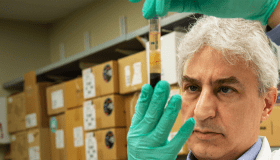
DENVER/September 28, 2021 – Head and neck cancers of cats are devastating and almost universally fatal, but a new therapy offers hope for suffering pets. Morris Animal Foundation-funded researchers at Utrecht University in the Netherlands are using light and a tumor cell targeted light-sensitive chemical to precisely trigger cancer cell death.
“There is a great need for treatments of this specific type of cancer, oral squamous cell carcinoma,” said Dr. Sabrina Santos Oliveira, Associate Professor at Utrecht University. “Nanobody-targeted photodynamic therapy could provide a new opportunity for treating cats with this cancer.”
Oral squamous cell carcinoma is the most common oral cancer in cats, accounting for roughly 8% to 10% of all cancers diagnosed. The cancer spreads locally and imbeds deeply into the oral tissue, and complete surgical removal is rare. The tumors make eating and drinking difficult and are very painful. Chemotherapy and radiation treatments provide only temporary relief and can have significant side effects. The average survival time is a dismal three months for cats diagnosed with this cancer.
Conventional photodynamic therapy uses light and a light-sensitive chemical to treat cancer. This chemical is given topically or intravenously to a patient, and then the light source is focused on any abnormal tissue. On their own, neither the light nor the chemical is harmful, but the light triggers the chemical agent to react with oxygen which in turn results in the production of harmful substances. These substances, known as reactive oxygen species, are toxic to the local cancer cells, ultimately leading to cell death.
Nanobody-targeted photodynamic therapy takes the process a step further. Treatment with conventional therapy has drawbacks, including limited specificity, timing issues and the need to avoid sunlight for several weeks after therapy, all major inconveniences for many cat owners. Nanobody-targeted photodynamic therapy uses tumor-cell targeted antibody fragments, coupled to the chemical, to more precisely target cancerous tissue. Light is used to trigger the chemical, but time delays and the need to avoid sunlight are eliminated.
Oral squamous cell carcinoma in cats is a cancer that appears amenable to this treatment, and the team is hopeful that the therapy will be a safe, quick and effective way to help cats suffering from this disease.
“I cannot stress enough the need for new treatments for this terrible cancer,” said Dr. Janet Patterson-Kane, Morris Animal Foundation Chief Scientific Officer. “If effective, nanobody-targeted photodynamic therapy could help thousands of cats affected by oral squamous cell carcinoma each year.”
Dr. Santos Oliveira began the basic research portion of her study in February and hopes to move the treatment to clinical cases in the next few months. She anticipates it will take two years before the study is complete.
About Morris Animal Foundation
Morris Animal Foundation’s mission is to bridge science and resources to advance the health of animals. Headquartered in Denver, and founded in 1948, it is one of the largest nonprofit animal health research organizations in the world, funding more than $142 million in critical studies across a broad range of species. Learn more at morrisanimalfoundation.org.




